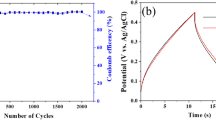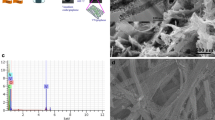Abstract
The modern drug delivery research strives to utilize novel materials and fabrication technologies for the preparation of robust drug delivery systems to combat acute and chronic diseases. So, the development of a general platform for efficient on-demand delivery of a variety of drugs remains an unachieved task. In this work, we report novel hybrid electrochemical interface based on carboxymethyl cellulose/N-doped porous reduced graphene oxide (CMC–NG) for on-demand delivery of imatinib (IM). An efficient loading of IM, 78% at pH 7.0 and time 3 h was observed using a CMC–NG:IM weight ratio of 1 onto CMC–NG. It is found that CMC–NG makes stronger hydrogen binding than NG with IM due to the presence of oxygen functional groups of CMC. We showed that CMC–NG is an extremely efficient electrochemical platform and the addition of CMC to the NG matrix also increases the stability of the IM–CMC–NG interface and decreases the release rate of IM from IM–CMC–NG interface. Upon the application of +1.0 V, 89% of IM could be released in a time span of 2 h from the electrical interface into PBS (0.1 M) with pH 4.0. Also, the on-demand electrochemical release experiments showed that the release rate of IM from CMC–NG at of neutral and alkalin condition is slow, while a faster release rate in an acidic environment at pH 4.0 was observed. Thus, the CMC–NG could potentially acts as efficient on-demand electrochemical interface, which may be applied in drug delivery systems.






Similar content being viewed by others
REFERENCES
Fu, Y. and Kao, W.J., Drug release kinetics and transport mechanisms of non-degradable and degradable polymeric delivery systems, Expert Opin. Drug Delivery, 2010, vol. 7, p. 429.
Alsulays, B.B., Kulkarni, V., Alshehri, S.M., Almutairy, B.K., Ashour, E.A., Morott, J.T., Alshetaili, A.S., Park, J.B., Tiwari, R.V., and Repka, M.A., Preparation and evaluation of enteric coated tablets of hot-melt extruded lansoprazole, Drug Dev. Ind. Pharm., 2016, vol. 43, p. 789.
Cui, Ch., Sun, J., Wang, X., Yu, Zh., and Shi, Y., Factors contributing to drug release from enteric-coated omeprazole capsules: an in vitro and in vivo pharmacokinetic study and IVIVC evaluation in beagle dogs, Dose-Response: Int. J., 2020, vol. 18, no. 1, p. 1.
Sanjay, Sh.T., Dou, M., Fu, G., Xu, F., and Li, X., Controlled drug delivery using microdevices, Curr. Pharm. Biotechnol., 2016, vol. 17, p. 772.
Grassi, M. and Grassi, G., Mathematical modeling and controlled drug delivery: matrix systems, Curr. Drug Delivery, 2005, vol. 2, p. 97.
Labroo, P., Ho, S., Sant, H., Shea, J.E., Agarwal, J., and Gale, B., Modeling diffusion-based drug release inside a nerve conduit in vitro and in vivo validation study, Drug Delivery Trans. Res., 2020, vol. 11, no. 1, p. 154. https://doi.org/10.1007/s13346-020-00755-y
Stewart, S.A., Domínguez-Robles, J., Donnelly, R.F., and Larrañeta, E., Implantable polymeric drug delivery devices: classification, manufacture, materials, and clinical applications, Polymers, 2018, vol. 10, p. 1379.
Shi, J., Votruba, A.R., Farokhzad, O.C., and Langer, R., Nanotechnology in drug delivery and tissue engineering: from discovery to applications, Nano Lett., 2010, vol. 10, p. 3223.
Skiles, M. and Blanchette, J., Polymeric drug delivery systems in tissue engineering, in Engineering Polymer Systems for Improved Drug Delivery, John Wiley & Sons, 2013, p. 227.
Kakkar, A., Traverso, G., Farokhzad, O.C., Weissleder, R., and Langer, R., Evolution of macro molecular complexity in drug delivery systems, Nat. Rev. Chem., 2017, vol. 1, p. 0063.
Guo, X., Wang, L., Wei, X., and Zhou, S., Polymer-based drug delivery systems for cancer treatment, J. Polym. Sci. A: Polym. Chem., 2016, vol. 54, p. 3525.
Wertheimer, A.I., Santella, T.M., Finestone, A.J., and Levy, R.A., Drug delivery systems improve pharmaceutical profile and facilitate medication adherence, Adv. Ther., 2005, vol. 22, p. 559.
Kumari, A., Yadav, S.K., and Yadav, S.C., Biodegradable polymeric nanoparticles based drug delivery systems, Colloids Surf. B: Biointerfaces, 2010, vol. 75, p. 1.
Davoodi, P., Yeng Lee, L., Xu, Q., Sunil, V., Sun, Y., Soh, S., and Wang, Ch.H., Drug delivery systems for programmed and on-demand release, Adv. Drug Deliv. Rev., 2018, vol. 132, p. 104.
Fubini, B., Ghiazza, M., and Fenoglio, I., Physico-chemical features of engineered nanoparticles relevant to their toxicity, Nanotoxicology, 2010, vol. 4, p. 347.
Kettiger, H., Schipanski, A., Wick, P., and Huwyler, J., Engineered nanomaterial uptake and tissue distribution: from cell to organism, Int. J. Nanomed., 2013, vol. 8, p. 3255.
Casais-Molina, M.L., Cab, C., Canto, G., Medina, J., and Tapia, A., Carbon nanomaterials for breast cancer treatment, J. Nanomater., 2018, vol. 2018, p. 1.
Nolan, H., Mendoza-Sanchez, B., Ashok Kumar, N., Mc Evoy, N., O’Brien, S., Nicolosi, V., and Duesberg, G.S., Nitrogen-doped reduced graphene oxide electrodes for electrochemical supercapacitors, Phys. Chem. Chem. Phys., 2014, vol. 16, p. 2280.
Mane, S.R., Advances of hydrazone linker in polymeric drug delivery, J. Crit. Rev., 2019, vol. 6, p. 1.
Samrot, A.V., Jahnavi, T., Padmanaban, S., Philip, S.A., Burman, U., and Rabel, A.M., Chelators influenced synthesis of chitosan-carboxymethyl cellulose microparticles for controlled drug delivery, Appl. Nanosci., 2016, vol. 6, p. 1219.
Bigucci, F., Abruzzo, A., Vitali, B., Saladini, B., Cerchiara, T., Gallucci, M.C., and Luppi, B., Vaginal inserts based on chitosan and carboxymethylcellulose complexes for local delivery of chlorhexidine: preparation, characterization and antimicrobial activity, Int. J. Pharm., 2015, vol. 478, p. 456.
Cerchiara, T., Abruzzo, A., Parolin, C., Vitali, B., Bigucci, F., Gallucci, M.C., Nicoletta, F.P., and Luppi, B., Microparticles based on chitosan/carboxymethylcellulose polyelectrolyte complexes for colon delivery of vancomycin, Carbohydr. Polym., 2016, vol. 143, p. 124.
Salem, W., Li, K., Krapp, C., Ingles, S.A., Bartolomei, M.S., Chung, K., Paulson, R.J., Nowak, R.A., and Mc Ginnis, L.K., Imatinib treatments have long-term impact on placentation and embryo survival, Sci. Rep., 2019, vol. 9, p. 2535.
Iqbal, N. and Iqbal, N., Imatinib: a breakthrough of targeted therapy in cancer, Chemother. Res. Pract., 2014, vol. 2014, p. 1.
Trela, E., Glowacki, S., and Błasiak, J., Therapy of chronic myeloid leukemia: twilight of the imatinib Era, ISRN Oncol., 2014, vol. 2014, p. 1.
Deininger, M.W. and Druker, B.J., Specific targeted therapy of chronic myelogenous leukemia with imatinib, Pharmacol. Rev., 2003, vol. 55, p. 401.
Droogendijk, H.J., Kluin-Nelemans, H.J., Van Doormaal, J.J., Oranje, A.P., Van De Loosdrecht, A.A., and Van Daele, P.L., Imatinib mesylate in the treatment of systemic mastocytosis, Cancer, 2006, vol. 107, p. 345.
Chekin, F., Myshin, V., Ye, R., Melinte, S., Singh, S.K., Kurungot, S., Boukherroub, R., and Szunerits, S., Graphene-modified electrodes for sensing doxorubicin hydrochloride in human plasma, Anal. Bioanal. Chem., 2019, vol. 411, p. 1509.
Chekin, F., Vasilescu, A., Jijie, R., Singh, S.K., Kurungot, S., Iancu, M., Badea, G., Boukherroub, R., and Szunerits, S., Sensitive electrochemical detection of cardiac troponin I in serum and saliva by nitrogen-doped porous reduced graphene oxide electrode, Sens. Actuators B, 2018, vol. 262, p. 180.
Singh, S.K., Dhavale, V.M., Boukherroub, R., Kurungot, S., and Szunerits, S., N-doped porous reduced graphene oxide as an efficient electrode, material for high performance flexible solid-state supercapacitor, Appl. Mater. Today, 2017, vol. 8, p. 141.
Nikkhah, Sh., Tahermansouri, H., and Chekin, F., Synthesis, characterization, and electrochemical properties of the modified graphene oxide with 4,4'-methylenedianiline, Mater. Lett., 2018, vol. 211, p. 323.
Zareyy, B., Chekin, F., and Fathi, Sh., NiO/porous reduced graphene oxide as active hybrid electrocatalyst for oxygen evolution reaction, Russ. J. Electrochem., 2019, vol. 55, p. 333.
Chekin, F., Singh, S.K., Vasilescu, A., Dhavale, V.M., Kurungot, S., Boukherroub, R., and Szunerits, S., Reduced graphene oxide modified electrodes for sensitive sensing of gliadin in food samples, ACS Sens., 2016, vol. 1, p. 1462.
Bagheri Ladmakhi, H., Chekin, F., Fathi, Sh., and Raoof, J.B., Electrochemical sensor based on magnetite graphene oxide/ordered mesoporous carbon hybrid to detection of allopurinol in clinical samples, Talanta, 2020, vol. 211, p. 120759.
Author information
Authors and Affiliations
Corresponding authors
Ethics declarations
The authors declare that they have no conflict of interest.
Rights and permissions
About this article
Cite this article
Nazila Samimi Tehrani, Masoumi, M., Chekin, F. et al. Hybrid Interface Based on Carboxymethyl Cellulose/N-Doped Porous Reduced Graphene Oxide for On-Demand Electrochemical Release of Imatinib. Russ J Electrochem 57, 885–891 (2021). https://doi.org/10.1134/S1023193521080139
Received:
Revised:
Accepted:
Published:
Issue Date:
DOI: https://doi.org/10.1134/S1023193521080139




